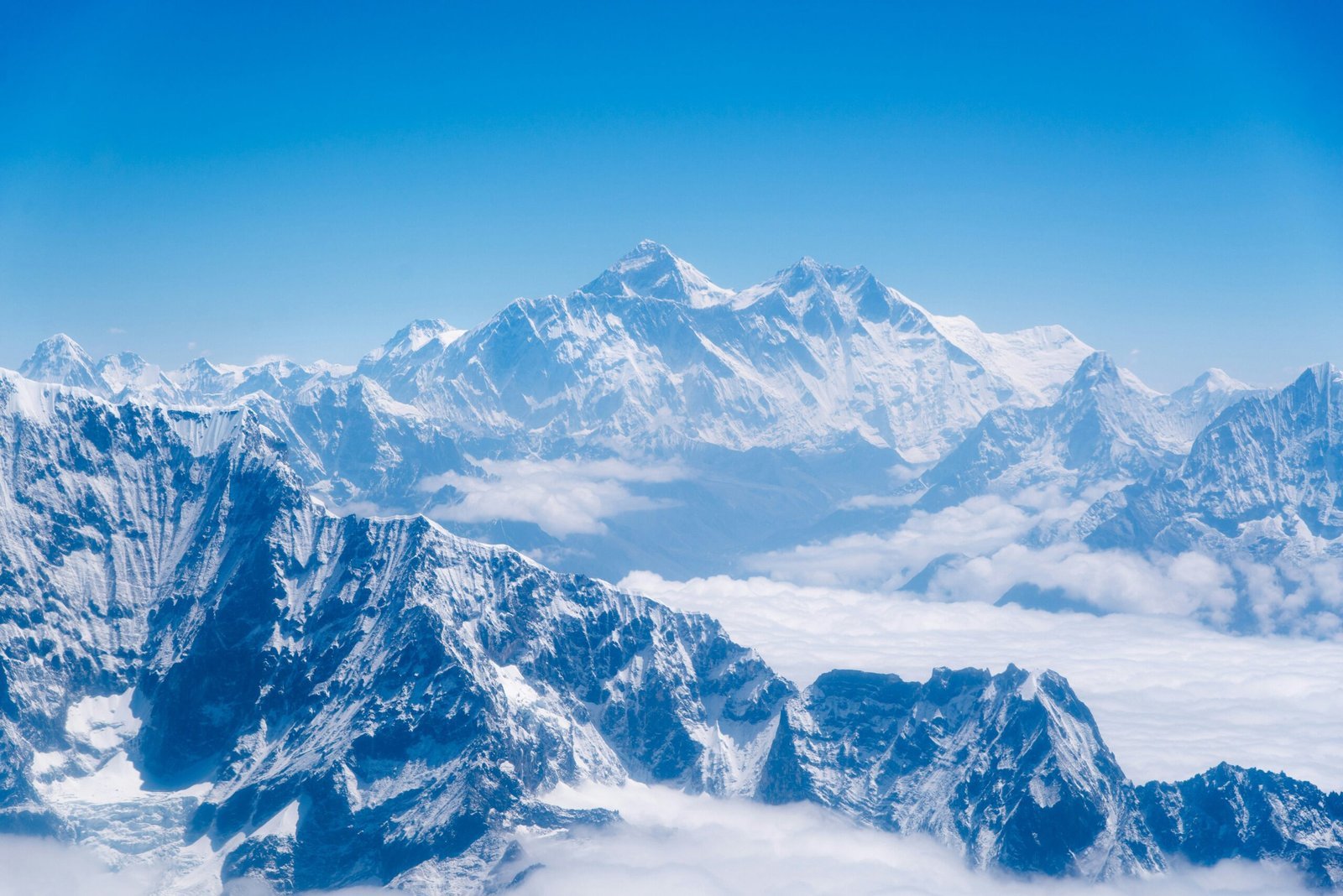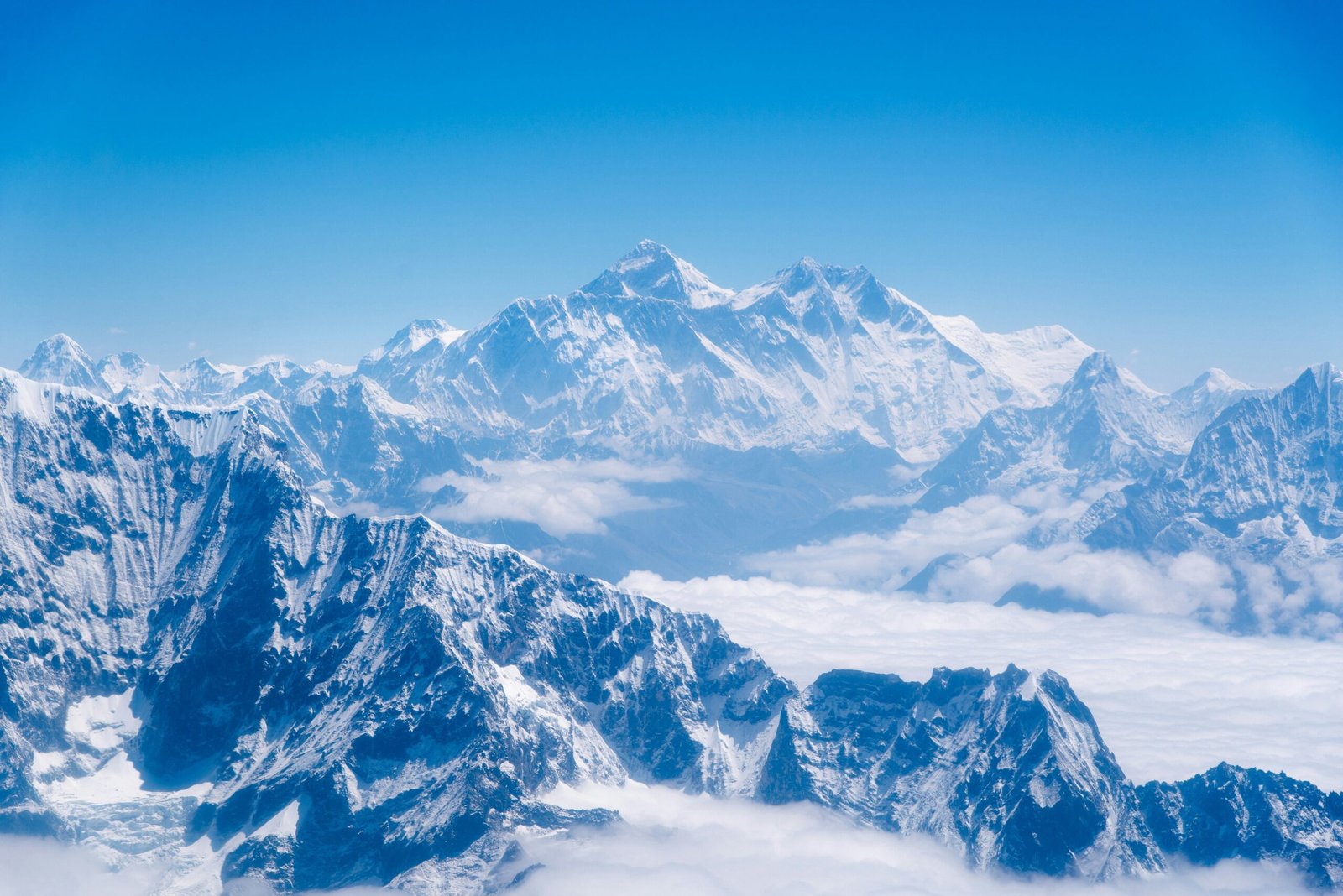
Introduction to Mount Everest
Mount Everest, towering at an awe-inspiring 8,848 meters (29,029 feet), holds the prestigious title of the highest peak on Earth. Situated majestically on the border between Nepal and the Tibet Autonomous Region of China, this colossal natural wonder has captivated the imaginations of adventurers and explorers for generations. Its formidable height and imposing presence make it a symbol of nature’s grandeur and an ultimate challenge for mountaineers worldwide.
The geographical location of Mount Everest is unique, straddling two distinct regions with rich cultural and historical backgrounds. To the south lies Nepal, a country known for its diverse topography and vibrant traditions. The northern face of Everest is located in the Tibet Autonomous Region of China, an area renowned for its spiritual heritage and breathtaking landscapes. This duality adds layers of intrigue and complexity to the mountain, making it not just a geographical marvel but also a cultural icon.
Mount Everest’s significance extends far beyond its sheer physical dimensions. For mountaineers, scaling Everest represents the pinnacle of achievement, a test of endurance, skill, and determination. The mountain has become a global emblem of human aspiration and perseverance. Climbers from around the world are drawn to its slopes, each seeking to conquer not just the peak but their own personal limits. The allure of Everest is such that it continues to attract both seasoned climbers and enthusiastic novices, each hoping to etch their names into the annals of mountaineering history.
In addition to its appeal to adventurers, Mount Everest also holds considerable scientific and environmental significance. It serves as a natural laboratory for studies on climate change, geology, and high-altitude physiology. Researchers and scientists frequently undertake expeditions to Everest to gain insights into the Earth’s climate patterns and the effects of altitude on the human body. Thus, Mount Everest is not only a beacon for climbers but also a vital site for scientific exploration and discovery.
Mount Everest, towering at 8,848 meters (29,029 feet), stands as the highest peak on Earth and has long captivated adventurers and geographers alike. Known locally as “Sagarmatha” in Nepal and “Chomolungma” in Tibet, the mountain was first brought to the world’s attention in the mid-19th century. It was during the Great Trigonometric Survey of India, conducted by the British, that the peak was identified and subsequently named after Sir George Everest, the Surveyor General of India from 1830 to 1843.
The allure of Mount Everest has been a siren call for explorers and climbers for over a century. The early 20th century witnessed numerous attempts to reach its summit, many of which ended in failure and tragedy. Notable among these early expeditions was the British-led team of 1924, where climbers George Mallory and Andrew Irvine disappeared, sparking a mystery that remains unsolved to this day: Did they reach the summit before their demise?
It wasn’t until May 29, 1953, that the summit was finally conquered. New Zealander Sir Edmund Hillary and Nepalese Sherpa Tenzing Norgay accomplished this historic feat, marking a monumental milestone in the annals of mountaineering. Their successful ascent symbolized human determination and the relentless pursuit of exploration, inspiring countless climbers to follow in their footsteps.
Since that pioneering achievement, Mount Everest has witnessed numerous key milestones. In 1975, Junko Tabei of Japan became the first woman to reach the summit. The 1980s saw Reinhold Messner, the legendary Italian mountaineer, achieve the first solo ascent without supplemental oxygen. More recently, in 2019, Kami Rita Sherpa set a record with his 24th ascent, highlighting the significant role of the Sherpa community in facilitating climbs.
These historic climbs and milestones not only underscore the mountain’s majestic allure but also its formidable challenges. Each ascent builds upon the legacy of those who have dared to confront the King of the Mountains, making Mount Everest a timeless symbol of human endurance and aspiration.
Geographical and Climatic Challenges
Mount Everest, the highest peak on Earth, presents an array of geographical and climatic challenges that make it a formidable endeavor for even the most seasoned climbers. The mountain’s terrain is marked by extensive glaciers, deep crevasses, and perilous sheer cliffs. These geographical features pose significant risks, requiring climbers to navigate with extreme caution to avoid potentially fatal falls and accidents. The Khumbu Icefall, for example, is a notorious glacier with constantly shifting ice and deep crevasses that climbers must cross early in their ascent.
The climatic conditions on Mount Everest further compound the difficulty of the climb. The temperatures are exceptionally low, often plummeting to -60 degrees Celsius (-76 degrees Fahrenheit) or lower, especially during the winter months. These frigid temperatures can lead to severe frostbite and hypothermia, making proper gear and preparation crucial for survival. High winds, often reaching speeds of over 100 miles per hour, can create additional hazards, including avalanches and the risk of being blown off course.
Above 8,000 meters lies the infamous ‘death zone,’ where the atmosphere contains only about one-third of the oxygen found at sea level. This lack of oxygen places immense strain on the human body, leading to symptoms such as dizziness, shortness of breath, and impaired cognitive function. Climbers must use supplemental oxygen to mitigate these effects, but even with this assistance, the risks remain significant. Prolonged exposure to the death zone can result in severe altitude sickness, including high-altitude pulmonary edema (HAPE) and high-altitude cerebral edema (HACE), both of which can be life-threatening if not promptly treated.
These geographical and climatic challenges underscore the perilous nature of climbing Mount Everest. The combination of treacherous terrain and extreme weather conditions demands not only physical strength and endurance but also meticulous planning and respect for the mountain’s formidable environment.
Mount Everest, standing at a formidable 8,848 meters, offers multiple routes to its summit, with the Southeast Ridge from Nepal and the North Ridge from Tibet being the most frequented by climbers. Each of these routes presents its own unique set of challenges and notable landmarks that must be navigated with precision and care.
The Southeast Ridge from Nepal
The Southeast Ridge route, starting from Nepal, begins at the Everest Base Camp situated at an altitude of 5,364 meters. This initial stage serves as a crucial acclimatization point for climbers. The first major obstacle encountered on this route is the Khumbu Icefall, a treacherous segment characterized by shifting ice blocks and deep crevasses. As climbers ascend further, they face the Western Cwm, a relatively flat glacial valley that leads to the Lhotse Face. This steep, icy wall requires climbers to use fixed ropes to navigate safely.
Beyond the Lhotse Face lies the South Col, a high-altitude pass that marks the final stage before the summit push. The ascent from the South Col to the summit involves scaling the Hillary Step, a nearly vertical rock face that, despite its modest height of 12 meters, poses significant technical challenges. The summit itself offers a breathtaking panorama, a reward for enduring the arduous climb.
The North Ridge from Tibet
The North Ridge route, accessed from Tibet, begins at a higher altitude than its Nepalese counterpart, with the Base Camp located at 5,150 meters. Climbers must first traverse the East Rongbuk Glacier to reach the Advanced Base Camp at 6,500 meters. From here, the route ascends the North Col, a steep and icy section that leads to the North Ridge proper.
One of the critical challenges of the North Ridge is the Second Step, a daunting rock face at approximately 8,610 meters. This obstacle requires climbers to use ladders and ropes to navigate. The exposure to harsh winds and extreme cold adds to the difficulty of this ascent. Beyond the Second Step, climbers must negotiate the Third Step and the summit pyramid before finally reaching the summit.
Both routes, despite their distinct paths and challenges, demand immense physical endurance, technical skill, and mental fortitude. Climbers must be prepared to face the unpredictable weather conditions and the physiological effects of extreme altitude as they strive to conquer the world’s highest peak.
Preparation and Training for an Everest Expedition
Embarking on an Everest expedition demands meticulous preparation and rigorous training, far beyond the physical requirements alone. Achieving peak physical conditioning is an absolute necessity. Climbers must engage in a comprehensive fitness regimen that includes cardiovascular exercises such as running, swimming, and cycling, to build endurance and stamina. Strength training, particularly focusing on the core and leg muscles, is essential for the arduous ascents and descents that define the journey to the summit.
In addition to physical fitness, climbers need to develop technical climbing skills. Proficiency in using climbing equipment such as crampons, ice axes, and ropes is crucial. Practicing on smaller peaks and engaging in rock climbing can provide valuable experience and skill enhancement. These preparatory climbs also offer an opportunity to simulate the physical and mental challenges faced during the actual expedition.
Altitude training is another critical component of preparation. The human body needs to adapt to the low oxygen levels encountered at high altitudes. This acclimatization process can be facilitated through gradual exposure to increasing altitudes, either by spending time in high-altitude environments or using altitude training masks and chambers. Proper acclimatization can significantly reduce the risk of altitude sickness, a common and potentially life-threatening condition on Everest.
The importance of the right gear and equipment cannot be overstated. Climbers must invest in high-quality, weather-resistant clothing, reliable climbing boots, and essential gear such as tents, sleeping bags, and cooking equipment. Each item must be chosen for its durability and suitability for extreme conditions. Furthermore, climbers must be proficient in the use of this gear to ensure safety and efficiency during the expedition.
Support teams, including Sherpas, play an indispensable role in the success of an Everest expedition. These local guides and porters possess invaluable knowledge of the mountain and its routes, providing logistical support, carrying heavy loads, and setting up camps. Their expertise and experience are crucial in navigating the treacherous terrain and ensuring the safety of the climbers.
Mount Everest, standing tall at 8,848 meters, is not merely a geographical marvel but a testament to the indomitable human spirit. Throughout history, countless climbers have attempted to conquer this ultimate giant, driven by diverse personal motivations and an unyielding desire for achievement. For many, the summit represents the pinnacle of human endurance, an apex of both physical and psychological challenge.
One of the most compelling stories of triumph belongs to Sir Edmund Hillary and Tenzing Norgay, who, in 1953, became the first confirmed climbers to reach Everest’s summit. Their successful ascent marked a monumental achievement in mountaineering history and inspired generations of climbers. Equally notable is the story of Junko Tabei, who in 1975, became the first woman to reach the summit, breaking barriers and setting new standards of courage and determination.
However, the journey to Everest’s peak is fraught with peril. The psychological challenges posed by such an extreme endeavor are as daunting as the physical ones. Climbers must contend with acute mountain sickness, hypoxia, and the ever-present threat of avalanches and crevasses. The infamous “Death Zone,” above 8,000 meters, is particularly treacherous, where the oxygen levels are insufficient to sustain human life for extended periods.
Tragically, the mountain has claimed many lives. Among the most poignant stories is that of George Mallory and Andrew Irvine, who disappeared in 1924 during their summit attempt. Their fate remained a mystery until Mallory’s body was discovered in 1999, sparking debates about whether they might have been the first to reach the summit. Equally harrowing is the account of the 1996 disaster, where a sudden storm claimed the lives of eight climbers, bringing global attention to the extreme risks of high-altitude mountaineering.
The stories of those who have perished on Mount Everest serve as a sobering reminder of the mountain’s formidable power. Yet, they also underscore the extraordinary resilience and bravery of those who dare to challenge this king of the mountains. Each climber’s journey, whether one of triumph or tragedy, contributes to the enduring mystique of Mount Everest, inspiring awe and reverence in equal measure.
Environmental and Ethical Considerations
Mount Everest, the tallest peak on Earth, has become an emblem of both human achievement and environmental concern. The increasing number of climbers has led to significant environmental degradation, particularly in the form of waste management. Each climbing season, thousands of climbers, guides, and porters ascend Everest, leaving behind substantial waste, including discarded gear, oxygen canisters, and human waste. Despite efforts by various organizations to clean up the mountain, the sheer volume of waste continues to pose a serious challenge.
Climate change further exacerbates the environmental impact on Everest. Rising temperatures are causing glaciers and ice cliffs to melt at an alarming rate, increasing the risk of avalanches and altering the climbing routes. This not only makes the ascent more perilous but also impacts the local ecosystems that are already fragile. The melting ice also exposes more waste that was previously buried, adding to the environmental burden.
Overcrowding on Everest has become a critical issue as well. The allure of summiting the world’s highest peak has led to a surge in climbers, particularly during the short climbing season. This overcrowding results in bottlenecks at key points, such as the Hillary Step, where climbers are forced to wait in line, sometimes for hours, in extreme conditions. This not only endangers lives but also places additional strain on the mountain’s environment.
Ethical considerations surrounding Everest climbs have become increasingly prominent. The commercialization of Everest expeditions has raised questions about the responsibilities of climbers and tour operators. While the financial benefits for local economies are undeniable, the high cost of guided tours often leads to a focus on profit over safety and environmental stewardship. Furthermore, the reliance on Sherpas and other local guides, who face significant risks for comparatively low wages, raises ethical concerns about exploitation and fair compensation.
Addressing these environmental and ethical issues requires a multifaceted approach. Strict regulations on waste management, climber quotas to reduce overcrowding, and a focus on sustainable tourism practices are essential steps. Additionally, climbers and tour operators must prioritize ethical considerations, ensuring that their pursuit of the summit does not come at the expense of the mountain’s health or the well-being of those who call it home.
The Future of Mount Everest Expeditions
As the allure of Mount Everest continues to captivate adventurers worldwide, the future of Everest expeditions is poised for significant changes. Advancements in climbing technology are at the forefront of this evolution. Modern gear, improved weather forecasting, and enhanced communication systems are making climbs safer and more efficient. Lightweight, high-performance materials in climbing equipment reduce physical strain, allowing climbers to tackle the harsh conditions of Everest with greater ease. Additionally, real-time weather updates and satellite communication ensure that climbers can make informed decisions, thus increasing their chances of a successful ascent.
Changes in regulations are also shaping the future of Everest expeditions. The Nepalese government, recognizing the environmental and safety challenges posed by the increasing number of climbers, has implemented stricter permit requirements and waste management protocols. These measures aim to reduce overcrowding and minimize the ecological footprint left by climbers. Future regulations may further limit the number of permits issued annually, prioritize experienced climbers, and enforce stringent waste disposal rules to ensure the preservation of Everest’s pristine environment.
Sustainable tourism practices are becoming integral to the future of Everest expeditions. Eco-friendly base camps, renewable energy sources, and comprehensive waste management systems are being introduced to mitigate the environmental impact. Tour operators are increasingly adopting responsible tourism practices, emphasizing conservation and respect for local cultures. These initiatives not only protect the natural beauty of Everest but also support the well-being of the Sherpa communities who play a crucial role in guiding climbers.
Future generations will likely engage with Everest in ways that emphasize both adventure and preservation. Educational programs and awareness campaigns can foster a deeper appreciation for Everest’s natural and cultural heritage. By promoting sustainable practices and responsible climbing, future adventurers can ensure that Mount Everest remains the ultimate giant and a testament to human perseverance, while safeguarding its grandeur for generations to come.



